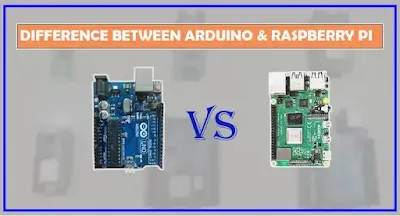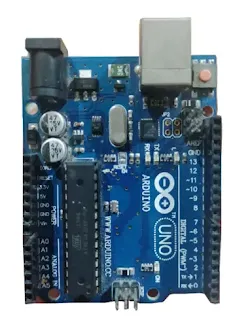Today we are going to see the comparison between Arduino & Raspberry Pi. Before that, we have known the basics of Arduino and Raspberry Pi.
What is Arduino??
Arduino is an open-source electronics
platform based on easy-to-use hardware and software. It's designed to make it
simple for hobbyists, designers, and professionals to create interactive
projects that can sense and control the physical world.
Arduino has a flash memory of 32kb, SRAM of 2kb & EEPROM of 1kb. Flash memory and EEPROM memory are non-volatile (the data is still present even after the power is turned off). SRAM is volatile means information will be lost when the power is cycled. Arduino uses SPI, I2C communication & UART communication protocols to communicate Arduino with another device. Arduino boards are able to read inputs - a light on a sensor, a finger on a button, or a Twitter message - and turn it into an output - activating a motor, turning on an LED, or publishing something online. You can tell your board what to do by sending a set of instructions to the microcontroller on the board, this set of instructions is written in the Arduino programming language (which is based on Wiring), and the Arduino Software (IDE), based on Processing.
Arduino is widely used in thousands of
different projects and applications. The platform is a great tool for making
interactive objects, taking inputs from a variety of switches or sensors, and
controlling a variety of lights, motors, and other physical outputs. Arduino projects
can be stand-alone, or they can communicate with software running on a computer
(e.g., Flash, Processing, MaxMSP). Arduino boards can be built by hand or
purchased pre-assembled.
There are different types of Arduino boards available
- Arduino Uno: This is the most common Arduino board, great for beginners and simple projects.
- Arduino Mega: It's like the Uno, but with more pins and memory - great for bigger projects.
- Arduino Leonardo: Similar to the Uno, but with a different microcontroller that allows for different functionalities.
- Arduino Nano: A small, breadboard-friendly board.
What is Raspberry Pi??
Raspberry Pi is a series of low-cost, credit-card-sized single-board computers that can be used for a variety of purposes, such as learning to program, running basic computer applications, and building DIY projects. The Raspberry Pi was first introduced in 2012 by the Raspberry Pi Foundation, a UK-based charity that aims to promote computer science education and the use of technology for social good.
The Raspberry Pi is designed to be an affordable and accessible platform for learning and experimentation. It is equipped with a processor, memory, USB ports, HDMI port, and other components that are found in traditional computers. It can be used as a standalone computer, or as a component in a larger project, such as a home automation system, a media center, or a gaming console.
The Raspberry Pi runs on Linux-based operating systems, such as Raspbian, which is specifically designed for the Raspberry Pi. It can also run other operating systems like Ubuntu, Windows 10 IoT Core, and others.
One of the key features of the Raspberry Pi
is its versatility. It can be used in a wide range of applications, from basic
programming projects to complex industrial control systems. It has become a
popular platform for makers, hobbyists, educators, and researchers.
The Raspberry Pi is also supported by a large and active community of developers, users, and enthusiasts. There are many online resources, tutorials, and forums dedicated to Raspberry Pi, making it easy for anyone to get started with this platform.
Overall, the Raspberry Pi is a powerful and flexible platform that offers an affordable and accessible way to learn programming, experiment with electronics, and build DIY projects. Its popularity has contributed to the growth of the maker movement and has inspired many people to explore the possibilities of technology.
- Raspberry Pi 1 Model B+: Released in July 2014, this was an improved version of the original Model B. It included more GPIO pins, more USB ports, a micro SD slot, and lower power consumption.
- Raspberry Pi 2 Model B: Released in February 2015, this model had a 900 MHz quad-core processor and 1GB of RAM, which made it 6 times faster than its predecessors.
- Raspberry Pi 3 Model B: Launched in February 2016, this version has a 1.2 GHz 64-bit quad-core processor, integrated 802.11n wireless LAN, and Bluetooth 4.1.
- Raspberry Pi 3 Model B+: Released in March 2018, it featured a 1.4GHz 64-bit quad-core processor, dual-band wireless LAN, Bluetooth 4.2/BLE, faster Ethernet, and power-over-ethernet support.
- Raspberry Pi 4 Model B: Released in June 2019, it came with a 1.5GHz quad-core 64-bit ARM Cortex-A72 CPU, up to 8GB RAM, dual-band wireless LAN, Bluetooth 5.0, Gigabit Ethernet, and two USB 3.0 ports. It supports two monitors at once and supports up to 4K resolution.
- Raspberry Pi Zero and Zero W: These are smaller versions of the Raspberry Pi, which are very low cost (the Zero retails for just $5). The Zero W comes with integrated wireless LAN and Bluetooth.
- Raspberry Pi 400: Released in November 2020, this is essentially a Raspberry Pi 4 in a compact keyboard with a 64-bit quad-core Cortex-A72 (ARM v8) 1.8GHz processor, 4GB of RAM, wireless LAN, Bluetooth 5.0, Gigabit Ethernet, and two USB 3.0 ports.
- Raspberry Pi Pico: This is a microcontroller board, similar to the Arduino, that was released in January 2021. It's not a full-fledged computer like the other Raspberry Pi models but is great for electronics projects.
Comparison between Arduino vs Raspberry Pi
- Hardware:
Arduino is a microcontroller board designed for interfacing with electronic components like sensors, motors, and other devices. It has dedicated pins and hardware to connect and control these devices. Arduino boards are simple and compact, making them easily integrated into electronic circuits.
On the other hand, Raspberry Pi is a microcomputer
board designed to run a full-fledged operating system like Linux. It has more
complex hardware, including a CPU, GPU, and other components, making it a more
powerful computing platform.
- Programming:
Arduino is programmed using the C++ programming language, which is well-suited for low-level hardware control and interfacing. The Arduino software is easy to use and includes a simplified programming language called "Arduino Language," which is based on C++.
On the other hand, Raspberry Pi can be programmed using a variety of programming
languages, including Python, C, C++, and others. This makes Raspberry Pi a more
versatile platform for programming.
- Processing Power:
Raspberry Pi has a more powerful processor
than Arduino, making it capable of running complex applications and multitasking.
Raspberry Pi can handle tasks like web browsing, video playback, and running
desktop applications. At the same time, Arduino is designed for simpler tasks like
controlling motors, reading sensors, and interfacing with other electronic
components.
- Interfacing:
Arduino is specifically designed for
interfacing with electronic components and has dedicated pins and hardware for
this purpose. It can easily connect to sensors, motors, and other devices,
making it a popular platform for electronics projects. On the other hand,
Raspberry Pi can also interface with electronics but may require additional
hardware like a breadboard or expansion board.
- Connectivity:
Raspberry Pi has built-in Ethernet and
Wi-Fi connectivity, making it easy to connect to a network and access the
internet. It can also be connected to other devices like smartphones, tablets,
and laptops. Arduino, on the other hand, requires additional hardware like an
Ethernet or Wi-Fi shield to connect to a network.
- Cost:
Arduino boards are generally less expensive than Raspberry Pi boards. This is because Arduino boards are designed for specific tasks and have less complex hardware, while Raspberry Pi boards are designed to be more versatile and have more powerful hardware.
| Boards | Arduino | Raspberry pi |
|---|---|---|
| Type | Microcontroller | Microprocessor |
| Architecture | 8 bit | 64 bit |
| RAM | 2 kB | 1 GB |
| Internet Connectivity | Ethernet shields | both Built-in WIFI & Ethernet port |
| Bluetooth Connectivity | Not present (external Bluetooth module needed) | Built-in Bluetooth |
| SD card support | Not present (external module needed) | Built-in SD card slot |
| Software | C/C++ languages | Python, C, C++ |
| Operating System | No | Required |
| Operating Voltage | 5v | 5.1v |
| Cost | cheaper | expensive |
| Clock Speed | 16 MHz | 1.4 GHz |
| Family | Atmega Family | ARM Family |
| Ease of use | Easy and Simple for beginners | Complex and Hard to learn for beginners |
| Application | Use for simple Application Home Automation, Weighing Machines, smart dustbins | use for Advanced level Applications such as servers, Robotics, Desktop PC |
| USB | No USB support present | USB present for connecting mouse, keyboard |
| GPIO | 20 pins (5v, 14 digital pins, 6 analogs) | 40 pins (3.3v, no analog pins external ADC required |
| Task | use for the single-task operation | use for the multiple-task operation |
| Boards | Arduino Uno, Arduino Mega, Arduino Leonardo, Arduino Nano | Raspberry Pi 1 Model B+, Raspberry Pi 2 Model B, Raspberry Pi 3 Model B, Raspberry Pi 3 Model B+, Raspberry Pi 4 Model B, Raspberry Pi Zero and Zero W, Raspberry Pi 400, Raspberry Pi Pico |
Application of Arduino board
- Embedded systems
- Electronics projects
- Home Automation using Bluetooth, RF, Lora & WIFI (using Wi-Fi shield)
- DIY (Do-it-Yourself prototyping projects)
- Drones & 3d printing
- RC (Remote control) cars
- Robotics
- Air quality sensors, temperature sensors, fire detectors & Gas sensors
- Smart dustbin, Distance measurement & automatic hand sanitizer
Application of Raspberry Pi
- Home Automation
- Gaming Console
- Robotics
- Industrial Control
- web servers
- desktop replacements
Advantages of Arduino Uno
- Extreme Community support
- More number of GPIOs both analog & digital pins with PWM capabilities
- It’s completely open-source
- Beginner friendly
Advantages of Raspberry Pi over Arduino Uno
- Processing Power: Raspberry Pi has a much more powerful processor than Arduino
- Connectivity: Raspberry Pi has built-in Ethernet and Wi-Fi connectivity
- Operating System: Raspberry Pi can run a full-fledged operating system like Linux
- Programming Languages: Raspberry Pi can be programmed using a variety of programming languages, including Python, C, C++, and others
- Video and Audio Capabilities: Raspberry Pi has built-in video and audio capabilities
- User Interface: Raspberry Pi can be connected to a display and used as a standalone computer
In conclusion, Arduino and Raspberry Pi are
two popular hardware platforms used in electronics and programming projects.
They differ significantly in terms of hardware, programming, processing power,
and other factors. Arduino is a microcontroller board designed for low-level
hardware control and interfacing, while Raspberry Pi is a microcomputer board
designed to run a full-fledged operating system like Linux. Arduino is
programmed using the C++ programming language, while Raspberry Pi can be programmed
using a variety of programming languages. Raspberry Pi has a more powerful
processor than Arduino and is capable of running complex applications and
multitasking. Arduino is.




